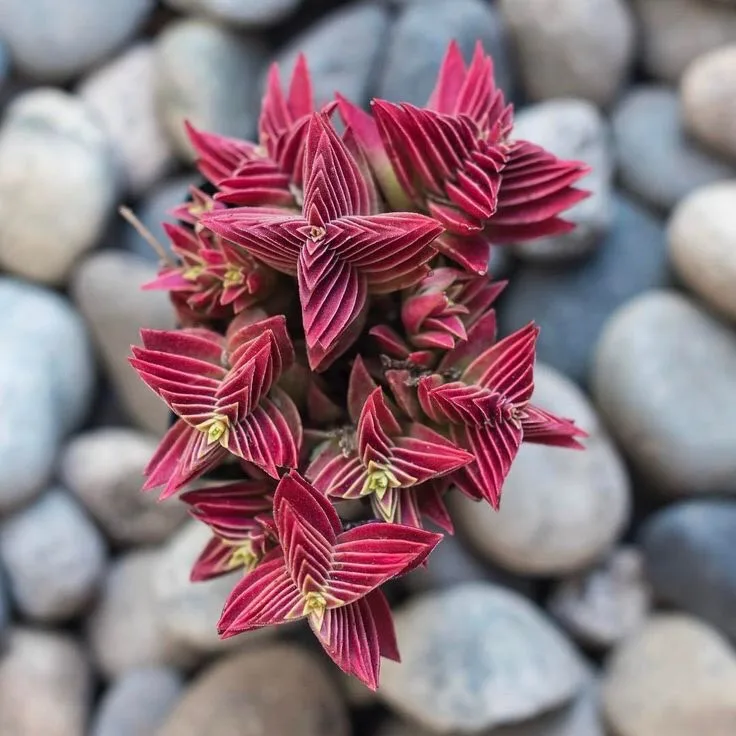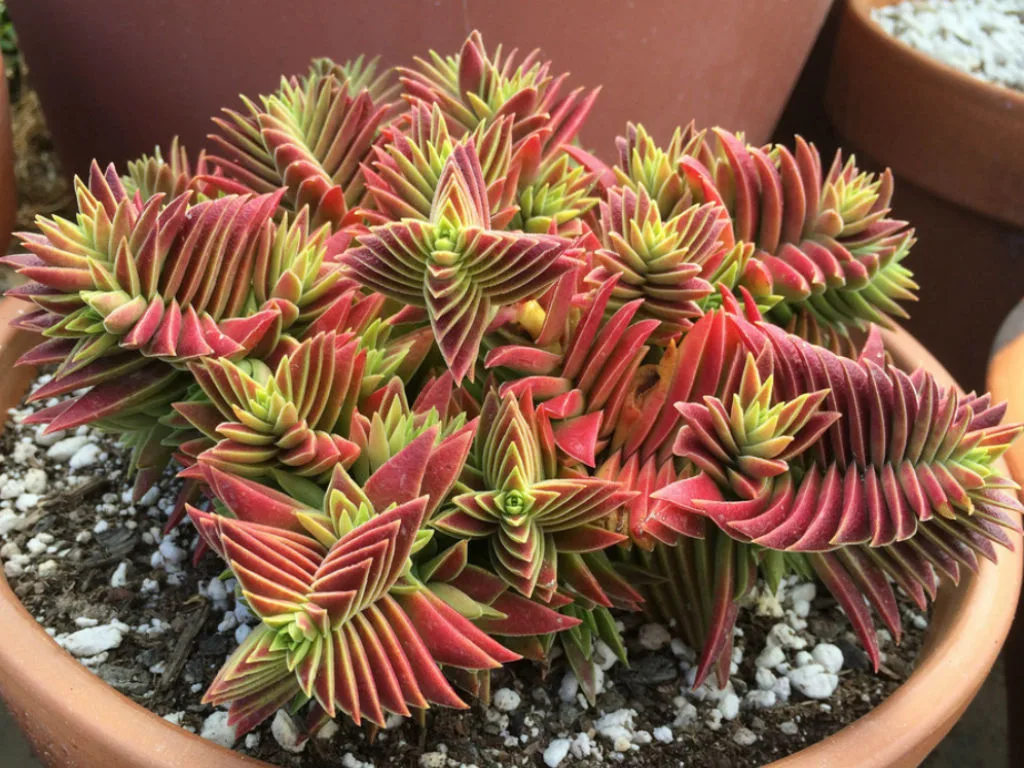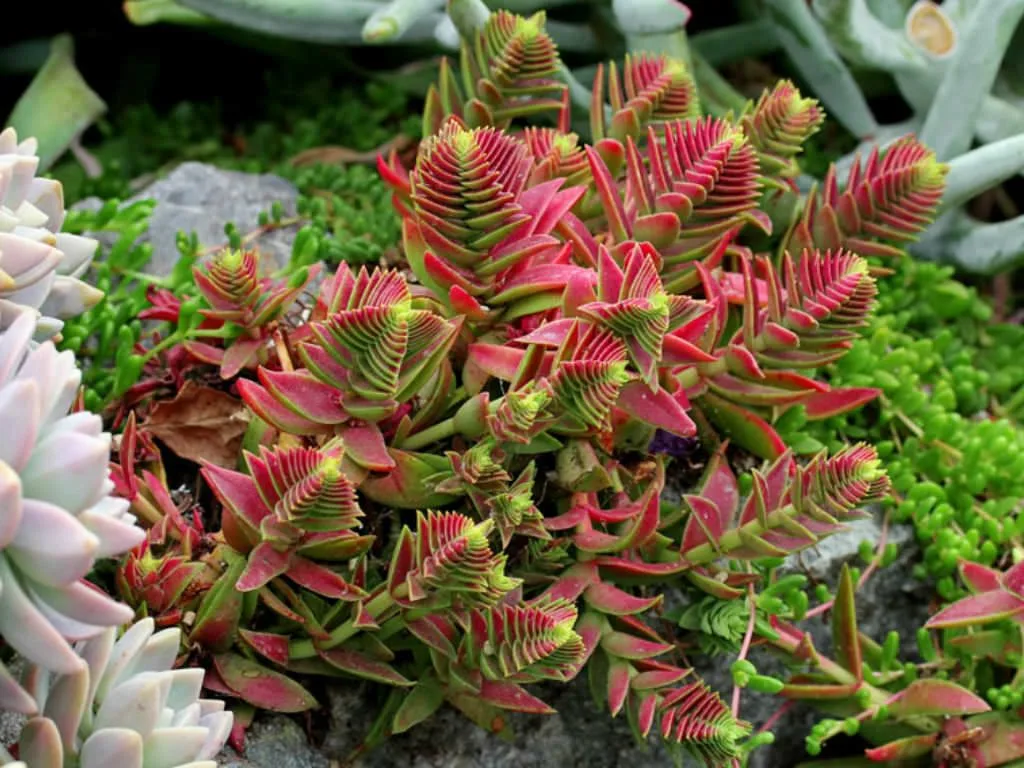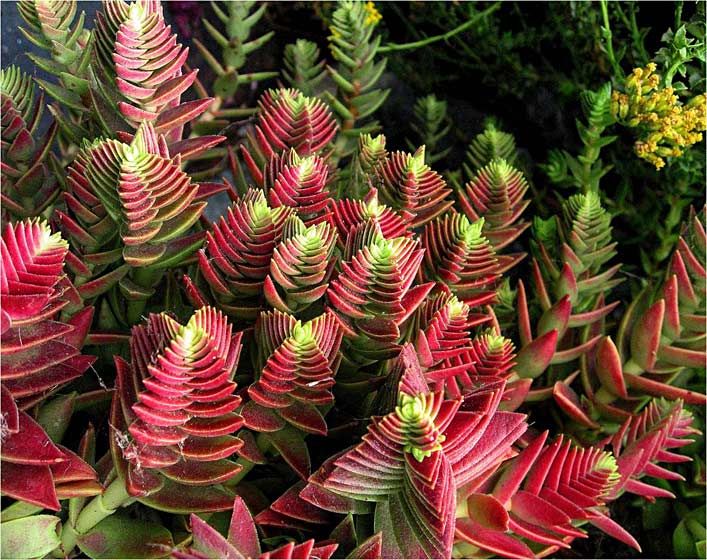table of contents
Introduction
The Shark’s Tooth Succulent, also known as the Crassula Red Pagoda, is a botanical gem that captivates with its unique leaves arranged in pagoda-like layers. Originally from South Africa, this succulent belongs to the genus Crassula, known for its sculptural forms and easy adaptation to domestic environments. Its popular name, Shark’s Tooth, refers to the leaves that resemble sharp teeth, providing a fascinating and incomparable appearance.
Meaning of Shark’s Tooth Succulent
The Crassula Red Pagoda is not only a visual masterpiece; its spirally arranged leaves are symbolic of harmony and balance in Feng Shui philosophy. The upward spiral of the leaves suggests continuous growth and progress, making it not only a charming addition to your succulent collection, but also a symbolic representation of prosperity and evolution in your space.
| Common Name | Shark’s Tooth Succulent |
|---|---|
| Botanical Name | Crassula Red Pagoda |
| Family | Crassulaceae |
| Plant Type | Succulent |
| Adult Size | Up to 30 cm tall |
| Sun exposure | Full sun to filtered light |
| Soil type | Well-drained |
| soil pH | Neutral to slightly acidic |
| Flowering Season | Spring to summer |
| Flower color | White or pink |
| Native Area | South Africa |
| Toxicity | Non-toxic, but may cause dermal irritation |

How to care for the Shark’s Tooth Succulent
The beauty of the Shark’s Tooth Succulent is directly linked to the care you give it. Follow these guidelines to ensure it flourishes:
Light:
It appreciates indirect light: Position the plant where it receives intense indirect light. Avoid direct sunlight for long hours, especially in regions with a hot climate.
Soil:
Drainage is essential: Opt for well-drained soil, preferably a specific mixture for succulents. This prevents water from accumulating in the roots.
Water:
Moderate watering: Allow the soil to dry out between waterings. Avoid overwatering, as Shark’s Tooth is susceptible to root rot.
Temperature and humidity:
Moderate Climate: Keep the plant in moderate temperature environments. This succulent appreciates normal levels of humidity.
Fertilization:
Moderate Fertilization: Fertilize during spring and summer with a balanced fertilizer for succulents, following the instructions on the product.
By following these guidelines, you will provide an ideal environment for the Shark’s Tooth to thrive and display all its splendor.

How to Make a Shark’s Tooth Succulent Cuttings
Have you fallen in love with the Shark’s Tooth Succulent and want to multiply its beauty? Here are the steps to create new seedlings:
How to Make Cuttings:
- Choosing the Leaves: Select healthy leaves from the mother plant. Prefer those that are mature, without significant damage.
- Healing: Let the chosen leaves dry for 1-2 days to form a healing layer at the base.
- Planting: Plant the leaves in succulent soil, slightly burying the base. Keep the soil moist until the seedlings emerge.
How to plant Shark’s Tooth Succulent
- Preparing the soil: Choose a pot with drainage holes and fill it with soil specifically for succulents.
- Planting: Plant the Shark’s Tooth, making sure the roots are covered. Leave adequate space between the plants.
- Initial watering: After planting, water lightly to establish the roots.
- Maintenance: Keep the pot in indirect light and water as necessary, avoiding waterlogging.
By following these guidelines, you’ll be growing not just plants, but new stories of beauty in your succulent collection.
Most common pests and diseases:
- Mealybugs: Regularly inspect the leaves and stems for the presence of these insects. Use neem oil to combat them.
- Mites: Spots and fine webs are signs of mites. Wash the plant with water to remove them or use neem oil.
- Root rot: Avoid overwatering to prevent root rot.
Common Problems and Their Solutions:
- Yellowing leaves: May indicate excess water. Adjust watering and make sure the soil is well drained.
- Stioling: Lack of light can cause elongated growth. Move to a brighter spot.
- Dark spots on the leaves: Too much direct sunlight can cause burns. Move the plant to a place with filtered light.
By identifying possible problems promptly and acting on the appropriate solutions, you will ensure that your Shark’s Tooth continues to thrive in all its exuberance.

Curiosities and myths
Curiosities:
- Interesting phylogeny: Shark’s Tooth belongs to the Crassulaceae family, which is home to a variety of succulents known for their unique shapes.
- Pagodiform Leaves: Its popular name, “Shark’s Tooth,” is derived from the unique arrangement of its leaves, similar to a shark’s teeth.
Myths:
- Toxicity: Contrary to common myths, Shark’s Tooth is not considered toxic, making it safe for domestic environments.
- Environmental Resistance: Despite its delicate appearance, this succulent is surprisingly hardy and adapts well to diverse conditions.
By exploring these curiosities and debunking myths, you gain a deeper understanding of the unique nature of Shark’s Tooth in its natural and domestic habitat.

Conclusion
Throughout this guide, we’ve delved into the fascinating world of the Sharktooth Succulent, learning about everything from its phylogeny to best care practices. The peculiarity of its pagodiform leaves adds a unique touch to any succulent plant collection, making it a delightful choice for gardeners of all levels.
By remembering to provide Shark’s Tooth with indirect light, well-drained soil and moderate watering, you will establish the ideal conditions for it to flourish. By propagating seedlings and solving possible common problems, you not only nurture a plant, but also create new opportunities to admire its beauty. Amid myths unraveled and curiosities revealed, the conclusion is clear: Shark’s Tooth is a captivating choice, adding a touch of exoticism and elegance to any green environment. By growing this extraordinary succulent, you are undoubtedly cultivating a true botanical treasure.
Frequently Asked Questions
How do I plant Crassula Capitella?
When planting Crassula Capitella, also known as “Coral Goblet,” it is crucial to choose well-drained, sandy soil. Make sure that the container or planting site has holes to ensure adequate water drainage. Place the plant at the appropriate depth, gently pressing the soil around the roots. After planting, water lightly to establish the succulent.
How to care for Crassula Campfire?
Crassula Campfire, with its vibrant orange and red leaves, requires specific care to maintain its exuberance. Place it in a spot with direct or partial sunlight, providing the ideal environment. As for watering, allow the soil to dry out completely between waterings, avoiding excess moisture. Also, fertilize during the growing season to promote its health and vibrant color.
How to care for a Crassula?
To care for a Crassula comprehensively, provide it with an environment with adequate sunlight, well-drained soil and moderate watering. Avoid waterlogging, as succulents cannot tolerate constantly damp soil. Fertilization can be carried out during the growing season, using a balanced fertilizer. Monitoring possible signs of pests and diseases is key to maintaining Crassula’s overall health.







